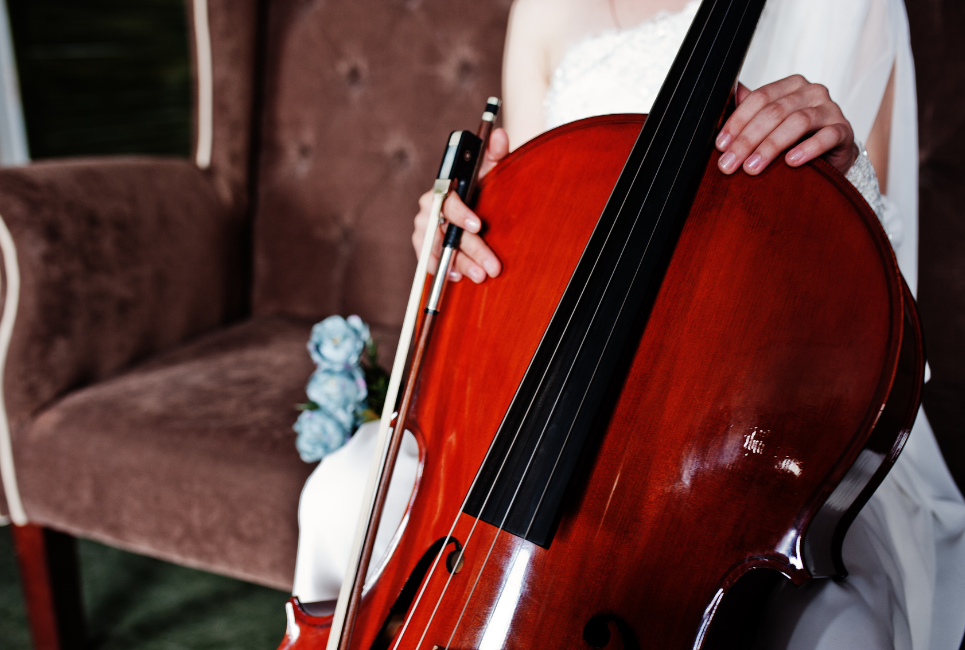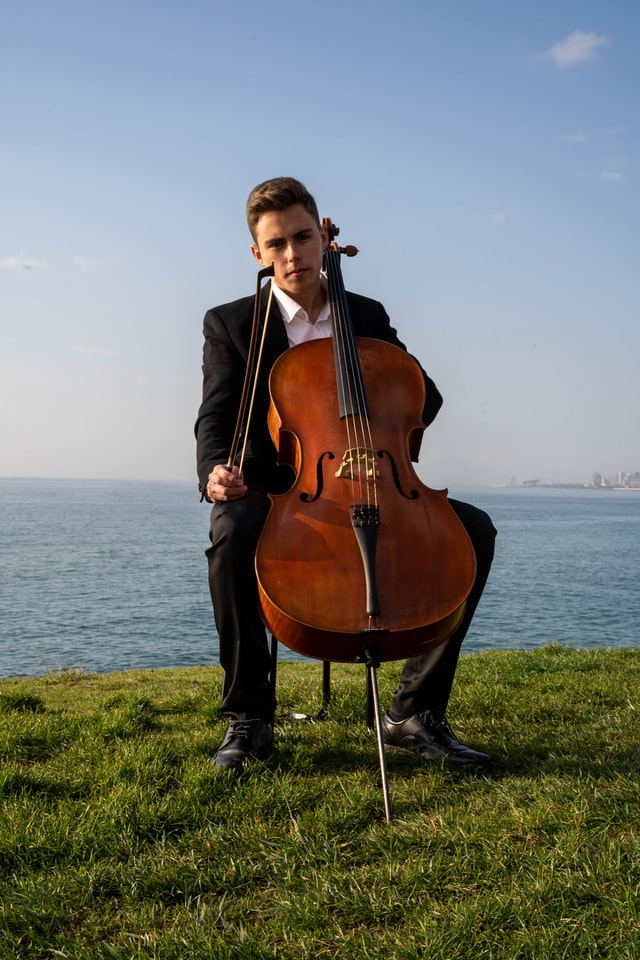- How to Find the Best 5 String Violins - April 21, 2022
- How to Hold a Violin Bow - April 21, 2022
- How to Hold a Cello Bow - April 17, 2022
Summary: Knowing how to find the best bass cello means knowing what size you need, what your budget is, correspondingly what your skill level is, and what materials are most important for your skill.
If you are trying to find the best bass cello, you might see a bunch of terms on music websites like “cello,” “bass,” and “upright bass.” What is the difference?
In my musical career, I was always very annoyed when people used terms interchangeably, even more so when they did not use them correctly. It is easy not to know the proper terminology when you first start, but that can lead to confusion, especially when searching for instruments or replacement parts online. Thankfully, the more I played an instrument, and the more instruments I played, the better equipped I was to use the right terms, the right way.
A cello and a bass cello can technically be the same thing, with a bass cello referring to the lower end of the sound created by the instrument. The upright bass is in the same family, but it is much larger than a cello, and instead of playing it sitting down in a cello chair, you play it standing up.
There are other differences, but for clarity, I will briefly cover the things that apply most to both a cello and an upright bass. These include:
- Size
- Budget and Skill
- Design and Materials
Size
When selecting a cello or a double bass, size is very important. Having the right sized instrument will allow you to play properly, learn the correct bow technique, and avoid any pain.
Sizing for a Cello
When you are ready to measure for the right size for a standard cello, you want to sit at the edge of a chair, placing both feet flat on the floor. Lean the cello so that it sits at a forty-five-degree angle against your body. The endpin on the bottom should be extended so that the top of the cello body rests right in the middle of your chest. If you go shopping for instruments in person, a sales associate or someone shopping with you can help you adjust the endpin as you sit in place. You should be able to reach both ends of your fingerboard top and bottom.
If you are unable to measure against your body with a physical instrument, you can refer to a sizing guide based on age and height:
| Cello Size | Age | Height |
| 1/10 cello | 3-4 | 3′ |
| ⅛ cello | 4-6 | 3′ – 3.5′ |
| ¼ cello | 6-8 | 3.5′ – 4′ |
| ½ cello | 8-10 | 4’-4.5′ |
| ¾ cello | 10-12 | 4.5’-5′ |
| 4/4 or full cello | 13+ | 5′ and taller |
Sizing for a Double Bass
When you are ready to measure for the right size for a double bass hello, when you stand next to it the bridge should be at the same height as the biggest knuckles on your right hand. What is most important, however, is that you can reach higher registers without any problems and the instrument can be held comfortably in your hand while you stand.
With the double bass cello, a three-quarter size is most common for adults and older teenagers. They do make other sizes, but these are typically reserved for incredibly tall people.
| Upright Bass Cello Size | Age |
| 1/16 | 3-4 |
| 1/10 | 4-5 |
| 1/8 | 5-7 |
| 1/4 | 7-9 |
| 1/2 | 9-13 |
| 3/4 | 13+ |
Now, when I started playing as a younger child, it made more fiscal sense to invest in the next size up if I was on the fence in terms of my age or my height. For example, with the cello, when I was 8 years old, I was on the short side so I could still get away with a 1/8 size cello but, I never knew when my growth spurts would happen, so we always invested in the next size up once I was close enough to that age or height.
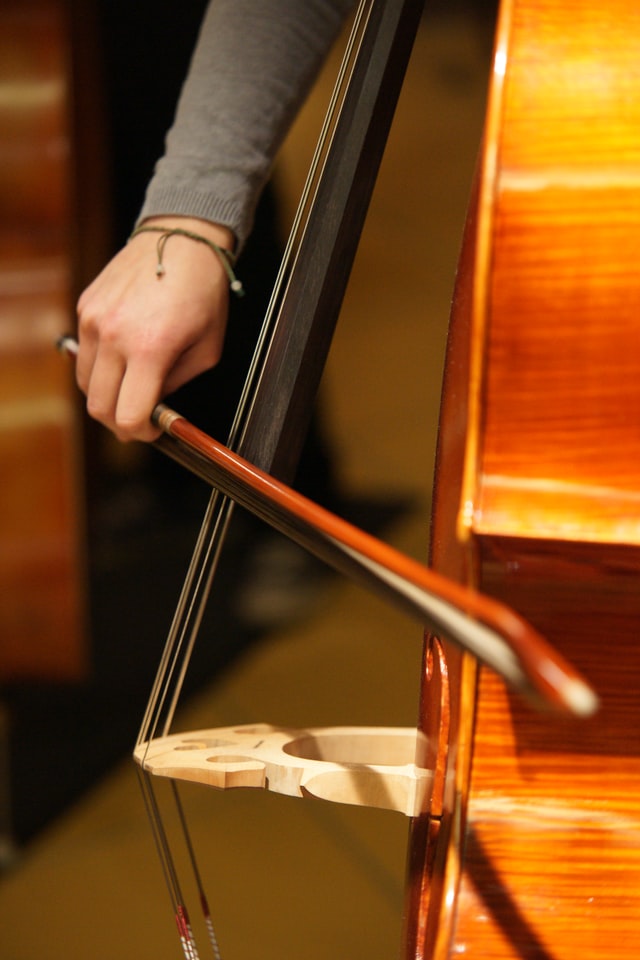
Budget
Finding the best bass cello also means understanding your budget and your skill level. These typically go together. As you start, you might have a lower budget for instruments because you are just beginning with a cello, and that is perfectly fine because you do not need anything too advanced or too expensive. But as you get more creative in your skills, you start playing with groups or performing, and then you can afford to invest in something on the higher end of the financial scale.
- Beginners should spend between $300 and $400 on a new bass cello
- Intermediates should spend between $400 and $1000 on a new bass cello
- Advanced musicians should spend a few thousand dollars on a new bass cello
Design and Materials
Once I grew out of the smaller sizes and needed an instrument with which I would play for the rest of my life (meaning, I was all grown up and would not change in height or arm span), I scoffed at how expensive instruments were. I was always frugal and never appreciated spending more money than necessary. For the first few years of playing, I would try to get by without rosin or with a soft case, and I did not care about what materials were used to make my cello.
As I got better, I could not believe that I had been so silly as to avoid using accessories or investing in materials that would help me even marginally improve my sound. Now I know that it is well worth the investment to get a high-quality instrument from the start so that you can make the most out of your skills as you cultivate them.
Note: I would not say that this applies to children. If you are a parent and your children are just getting started with the bass cello, I do not believe you should spend the highest amount of money possible for the best materials or design. A comprehensive kit that includes a cello, soft case, rosin, Beau, and folder for their music is just fine. You never know when kids will suddenly give up their instrument and never touch it again.
In this video, you can see a bit more about beginner bass cellos from different manufacturers:
So, what design or materials influence the cost most?
- Materials for the body
- Materials for the case
- Materials for the fingerboard
- Materials for the tailpiece
- Materials for the strings
Body
When you look at different bass cellos, the description will include different types of trees. Usually, the back of your instrument, the sides, and the neck are made from maple and the top part of the instrument is made with spruce. In beginner designs, you might see the back and the neck made of maple, the top made of spruce, and the side panels made of Poplar.
In more advanced designs, you will see carbon fiber instead of wood. Carbon fiber is a sturdier, more reliable, and much lighter material, but it is significantly more expensive, which is why it’s usually something only invested in by advanced or professional musicians.
This video demonstrates the difference in sound between a wood and carbon fiber bass cello:
Case
If you are a beginner or an intermediate musician, when you look at different cellos or bass cellos online or in a store, you might see top manufacturers provide kits. This means that instead of just getting the instrument itself, you get the instrument, the bow, the case, some rosin, extra strings, and a tuner.
These are great for beginners.
I have had a lot of trouble in the past trying to get replacement parts on a brand new instrument because I just didn’t know that much about the instrument yet so I didn’t know if I could buy Pirastro strings with a different rapping for only one of the strings on my instrument or if I had to stick with the same manufacturer that came with the instrument.
Kits like these usually come with extra strings, so you do not have to worry as I did. They also typically come with accessories you might not even know you need, like rosin. They do not usually have a lot of rosins, but they give you just enough that as a beginner, you can rosin your bow and increase the friction as you play.
Most beginner kits come with a soft case. A soft case is perfectly suitable if you only carry the instrument to and from school or music lessons.
As an intermediate or advanced musician, you might consider investing in a hard case to better protect your instrument, especially as you start to purchase more expensive cellos or bass cellos.
Fingerboard
The fingerboard, commonly called the fretboard, is where the strings run, and it is a very thin piece of wood usually laminated or finished. The harder the wood, the more expensive the instrument will be, but the more durable it will be.
Tailpiece
The tailpieces usually come constructed from ebony. Beginner designs have an ebony tailpiece, while intermediate designs have a hardwood or steel tailpiece. More advanced materials like hardwood or steel are more expensive.
Strings
As I said, if you get a beginner kit for your instrument, it will typically come with strings, and the strings are usually already attached. More comprehensive kits will give you an extra set of strings for when the first set breaks or is worn out. If you do not purchase a kit like this and all you get is the instrument itself, you will have to buy new strings down the line.
Even if you get a kit that comes with strings, you might be an intermediate player with skills such that you can hear a difference in the quality and tone produced by metal strings vs synthetic strings or strings that are wrapped with aluminum rather than strings that are wrapped with gold. As you become a more advanced musician you might consider swapping out the strings that come with your new bass cello for strings that give you the best sound based on what music you play.
In conclusion, knowing how to find the best bass cello comes down to finding the right size, the materials that suit your skill level and fall within your budget. As a beginner, you can get away with wood materials for the body, ebony for the tailpiece, and the kits that come with other accessories such as a bow, rosin, and a soft case. As you increase your skills, you might need something that responds better to your technique, in which case carbon fiber might be a consideration along with a hard case to protect your instrument.
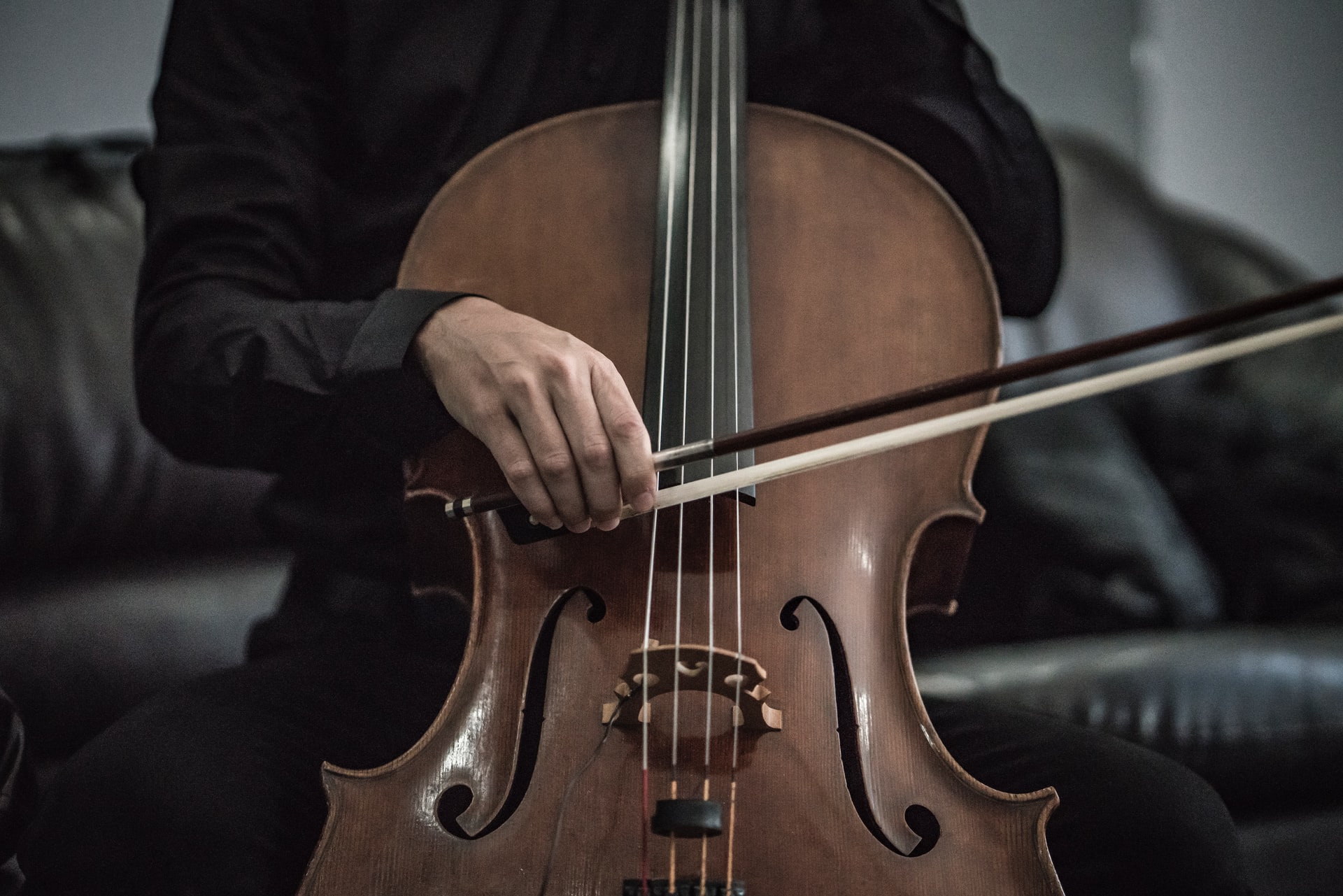
Best Bass Cello
Cellos and Bass are unique but still very similar. They both have a beautiful deep tone and are integral to rounding out an orchestra or ensemble. They are also expensive and a huge commitment. That’s why I’ve rounded up the best for every budget. I’ve based my choices on my own personal experience with strings instruments, makers that are well known among players, and reviews from those with in-depth personal experience.
Cello
Cecilio CCO-500

Cellos are expensive; student options often cost well over 1000 dollars. This is why most people rent their first cello. Some people can’t or don’t want to rent, and that’s why Cecilio makes various budget-level instruments. I won’t lie the less expensive instruments generally aren’t worth playing. But some of their more expensive instruments are actually of decent quality. They will see a student through their first few years of playing.
I consider the CCO 500 to be the start of playable instruments for Cecilio. While the other options have lower-quality materials and a thick lacquered varnish, the 500 steps up in quality in other ways with an ebony fingerboard and removable fine tuners that can be replaced if they break (which they will on these instruments).
It comes with everything you need to get started: a bow, hardcase with wheels, stand, strings, and rosin. I suggest taking this instrument into a luthier to be adjusted. The bridge may or may not come installed, and Cecilio isn’t that great at setting up instruments properly. A luthier can make sure it’s adjusted perfectly. I also recommend getting a new bow and new strings as well. A carbon fiber bow and Prelude strings would really help this instrument.
Pros
- Comes with a nice hard case, not a cheap gig bag.
- Inexpensive cello outfit
- Made from handcrafted woods
- Ebony fittings with removable fine tuners for when the Cecilio ones break.
Cons
- Poor setup
- Cheap strings
- Prone to manufacturer defects
- Will only stay with a student through the first couple of years
Tower Strings Entertainer

The Tower Strings Entertainer is the entry-level cello from Fiddlershop’s Tower Strings line, their version of a budget student line. This cello is considerably more expensive than the Cecilio but it packs a significant amount of quality for the price, and it’s still one of the most affordable cellos on the market.
This cello features aged tonewoods with ebony fittings. The tailpiece is aluminum with built-in fine tuners. I’ve never had experience with this particular tailpiece but the tailpieces on their violins and violas are of top quality and I’d expect nothing else from them. The cellos comes fully set up and ready to play with Prelude strings and a full outfit including a hard foam case, carbon fiber bow, rosin, endpin stop, practice mute, and tuner. The bows I can vouch for as top quality.
Pros
- Affordable quality cello
- From a well known retailer of orchestral strings for all levels of playing
- A good quality hand-carved student bridge, expect it to be a bit higher than a standard bridge.
- Quality accessories that won’t break
- Can follow a student into Orchestra
Cons
- Still expensive but affordable for this instrument
Fiddlerman Apprentice Cello

If you had some extra money to throw towards your new cello and don’t fancy the Tower Strings pick, the Apprentice may entice you more. The Fiddlerman brand focuses on student and intermediate instruments made from quality tonewoods and well setup. The Apprentice is a jump up from the Tower Strings line but still remains an affordable student cello.
The body is made from solid flamed aged tonewoods, ebony fittings and pegs, a hand-carved bridge with Prelude strings. It’s fully set up and ready to play out of the case with a full outfit. The accessories are pretty similar to the Tower Strings version but the case is a little nicer and has an extra storage pocket on the front.
Pros
- Sold by well-known retailers of Orchestral strings
- Setup by hand using their 10 point inspection
- Upgraded canvas case is extra durable and has good storage.
- Carbon composite tailpiece with built-in fine tuners similar to Wittner
- Great for a growing cellist
Cons
- May be too expensive for some
Bass
Cremona SB Premier
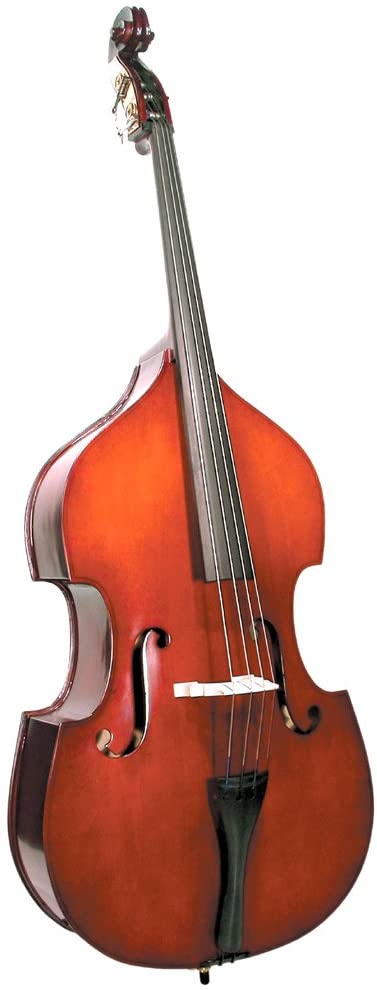
If you are on the hunt for a double bass then look no further than the Cremona SB Premier Novice Upright bass. Cremona is known for selling both instruments and their setup parts like bridges. Generally, their instruments come decently made and with a good setup. I consider them budget instruments but capable of being a good musical companion for some years.
This particular bass has been featured on the Grand Ole Opry live every night for some time. So you could say there’s a reason to give it a double look. Its made from a solid spruce top, curly maple back and sides, and an ebony fingerboard. It comes with a padded gig bag.
Pros
- Fully set up for optimal playability
- A traditional look thanks to the violin-shaped body and antique varnish
- Featured on the Grand Ole Opry regularly so you can check it out for yourself
- Affordable
Cons
- Comes with a gig bag, I prefer stronger cases for instruments shipped in the mail
- Doesn’t come with a bow
Core Academy A45

The Core Academy A45 is a small step up from their A40 version and a decent bit more expensive than the Cremona. It’s a lovely bass made with flamed maple solid spruce and an antique matte varnish. It has all ebony fittings including the tailpiece and the bridge had adjustable wheels. It comes set up with Helicore strings and is one of the favorites in the Core Academy Bass Series. It also includes a padded bass cover, brazilwood bow, rosin, and polishing cloth.
It is sold by Fiddlershop and well known retailer of various orchestral strings. They are known for selling quality student instruments that are actually playable. Along with a number of accessories, strings, and other essentials. I’m pleased see them expanding into the double bass world. Their reputation for quality and my experience is why I feel so comfortable recommending these instruments.
Pros
- Made by well-known retailers of student instruments
- Quality materials, setup, and strings
- Decent accessories included that are usable
- Geared tuning not pegs
Cons
- Padded bag not a hard case
- Some of their cheaper basses have poor reviews
Fiddlerman Master Double Bass

If you want a double bass that could be your final instrument (depending on your goals and preferences over time) then the Fiddlerman Master is a beautiful pick! It’s a German Pattern bass made with top-quality materials like wood that has been aged for 75 years and dried for 10 years. The wood is sourced from Russia and Asia. It has a 100% ebony fingerboard and tailpiece and is strung with Helicore strings.
This bass will come set up and ready to play out of the box, which is my favorite thing about Fiddlershop instruments. The setup uses quality bridges and is well adjusted, you can rely on them to make sure your bass sounds the best. Along with your instrument, you will receive a carbon fiber double bass bow.
Pros
- The aged and dried wood will give this bass an extra-deep sound and personality.
- Comes with a great setup that you can depend on
- Strung with quality strings
- Deep brown hand oil rubbed varnish look gorgeous
- Hand-carved bridge
Cons
- Expensive for new students
- Only comes in ¾ size not 1/2
FAQ
Answer: The best bass cello is the one that works for you. As a beginner, you can look for brands that cater to beginners, using the standard Maple and Spruce wood for the body, synthetic strings, and a kit with accessories. As an intermediate or advanced player, you might look for higher-quality designs, especially carbon fiber. There is no one-size-fits-all, but make sure that you pick the right size for your height and age, no matter the materials.
Answer: Cheap is a relative term. What is cheap for a brand-new student may differ from what is cheap for a professional. The prices you pay should fluctuate based on your skill level. More technically proficient musicians will need higher quality instruments that respond to their technique and their bow movements, which means they should expect to pay more for better designs. A cheaper bass cello might be perfectly suitable, especially if you are buying it used, so long as it is free from any chips or cracks, the fretboard is not bent, and the bridge stands straight up with both feet on the body.
Answer: Yes, any instrument you purchase should be protected with a case. As a beginner, a soft case is perfectly suitable for your stringed instrument. Still, as a more advanced player, especially a musician who travels to and from performances and practices regularly, a hard case is a better investment. Professionals will need a hard case with suspension foam built inside to cradle their instrument while it is shipped or stowed underneath an airline or on a cruise line.
Looking for more interesting readings? Check out:

